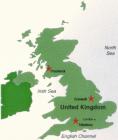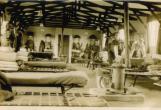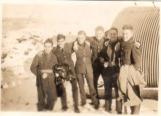1
The earliest radar stations, known as Chain Home (CH) Stations, were located along the eastern coast of England and Scotland. Twenty stations were operational by 1939 and proved their worth during the Battle of Britain by giving enough warning of incoming aircraft (up to 200km away!) that the British fighter pilots were able to respond. It gave the enemy the impression that the RAF had more planes than they thought, and allowed the British to use their aircraft in the most strategic locations. Soon after, Chain Home Low (CHL) radar stations were also built. These two types of radar were built throughout the United Kingdom, and were the first of many, many different types of radar developed by the Allied scientists during the war.2
A hand-drawn map of the United Kingdom by Charles W.Young, showing all the radar stations he knew of1943 to 1946
 Credits:
Credits:The Secrets of Radar Museum
Charles W. Young Collection
3
RDF (Radar) training was offered at three schools in the U.K.: Yatesbury, Cranwell and PrestwickWorld War II
 Credits:
Credits:The Secrets of Radar Museum
4
This victory bonds poster earned RCAF radar mechanic Haydn Llewellyn Davies a Mention in Despatches1940 to 1946
 Credits:
Credits:Private Collection
Courtesy of H.L. Davies and the Davies Family
5
Training at Cranwell, New Year's Day 19421 January 1942
Cranwell, England
 Credits:
Credits:The Secrets of Radar Museum
Bert Allen Collection
6
Service in Britain was a drastic change for the young recruits. Because they were sworn to the Official Secrets Act, they kept their work strictly secret. They were in a nation at war, where a total blackout was observed nightly, where recruits were billeted in private homes or crammed together in Nissen huts (corrugated steel structures with a concrete base), or other civilian buildings adapted to wartime use.7
At the Overseas Forces Club, ca. 1942Circa 1942
 Credits:
Credits:The Secrets of Radar Museum
Bert Allen Collection
8
Inside "Canada House"; An RCAF Radar personnel's "home away from home"September 1942
Woodvale, Lancashire, England
 Credits:
Credits:Private Collection
Courtesy of J. Tevlin
9
The CH and CHL stations were under the control of No. 60 Group, and under the operational control of Fighter Command Group. The quick and ongoing development of radar by 60 Group and the British enabled the Allied Forces to take radar units with them to the Continent and across the world using mobile units. In particular, the work of the Telecommunications Research Establishment (TRE), a group of scientists within the Bawdsey Research Group in England, was responsible for a great deal of the new technologies developed.The various types of mobile and airborne radar units are too numerous to list here, however, the continual development of warning systems for aircraft, and portable ground units, were invaluable to the RAF and RCAF, not only in the United Kingdom, but in Canada, Europe and in every overseas theatre of war. Each type or group was given an "AMES" number to identify it, which stands for "Air Ministry Experimental Station". (For example, Chain Home radar was also known as AMES Type 1). Several types are illustrated in the exhibit. Secrecy was so important that very few people were trained on more than one or two types of equipment.
10
AMES Type 16 in use at RAF Greyfriars1941 to 1945
RAF Greyfriars, United Kingdom
 Credits:
Credits:Private Collection
Courtesy of J.L. Brown
11
AMES Type 16, overlooking RAF Hythe, near Southampton on the south coast of England1940 - 1945
RAF Hythe, Hampshire, England
 Credits:
Credits:Private Collection
Courtesy of J.L. Brown
12
The quarters were cramped inside this Nissen hut in Ballykelly, Northern Ireland1941 to 1945
Ballykelly, Northern Ireland
 Credits:
Credits:The Secrets of Radar Museum
Ken Southcott Collection
13
Personnel outside a Nissen hut, at Rodel, Scotland.December, 1942
Rodel, Scotland
 Credits:
Credits:The Secrets of Radar Museum
Bert Allen Collection
14
Britain also recruited and conscripted large numbers of single women to monitor radar screens and replace male radar operators who were needed overseas. The Women's Auxiliary Air Force (WAAF) completely dominated the English coastal radar stations by 1943. Many worked as operators or plotters in Filter Rooms, where all aircraft in the area were tracked on large maps and tables so that the commanding officers could see exactly what was happening and make the best decision about where to send their Squadrons.Members of the WAAF worked closely with Canadian radar mechanics (resulting in many later emigrating to Canada as war brides). Working at the stations was not easy, and many experienced bombing raids and counter attacks by the Germans. Those who worked with radar knew that a nation depended upon their vigilance and the early warning and assistance that they were able to give the Allied troops.